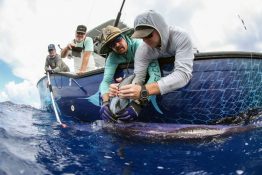Researchers from the University of Washington are using high-tech tags to record the movements of swordfish — big, deep-water, migratory, open-ocean fish that are poorly studied — and get a window into the ocean depths they inhabit. The researchers tagged five swordfish in late August off the coast of Miami: Max, Simone, Anthony, Rex and Oliver. Their movements can now be viewed in near-real time.
Read more at UW News »Washington’s first student-built satellite preparing for launch
A University of Washington satellite smaller than a loaf of bread will, if all goes well, launch this weekend on its way to low-Earth orbit. It will be the first student-built satellite from Washington state to go into space. HuskySat-1 is one of seven student-built satellites from around the country scheduled to launch at 9:30 a.m. Eastern time Saturday, Nov. 2, from NASA’s Wallops Flight Facility on the Virginia coast.
Read more at UW News »Creepy, slimy and flat-out gross: marine edition
To commemorate the season of all things spooky, gross and disturbing, we’ve compiled a list of some of the creepiest creatures to be found in the waters of the Pacific Northwest. To kick things off, we dip our toe into the salty waters of the Salish sea, where UW’s Friday Harbor Laboratories (FHL) are situated. These labs make the ideal setting to study the marine world, and provided us with no shortage of horrors to include in this list.
Read more »Precision mapping with satellite, drone photos could help predict infections of a widespread tropical disease
Satellite images, drone photos and even Google Earth could help identify communities most at risk for getting one of the world’s worst tropical diseases. A team led by the University of Washington and Stanford University has discovered clues in the environment that help identify transmission hotspots for schistosomiasis, a parasitic disease that is second only to malaria in its global health impact.
Read more at UW News »State of the College 2019
Learn what Dean Graumlich shared at her annual address.
Read more »





